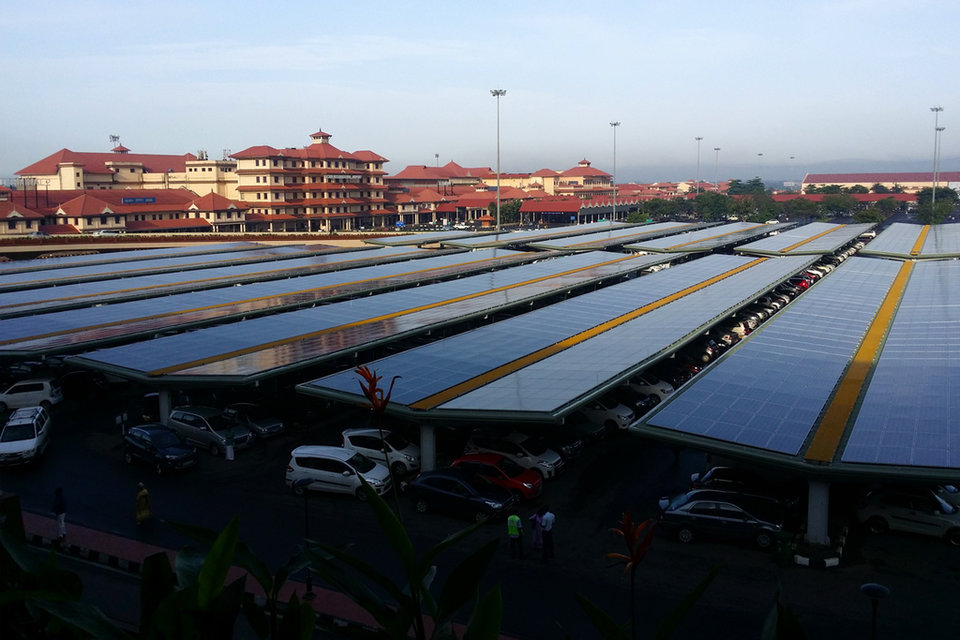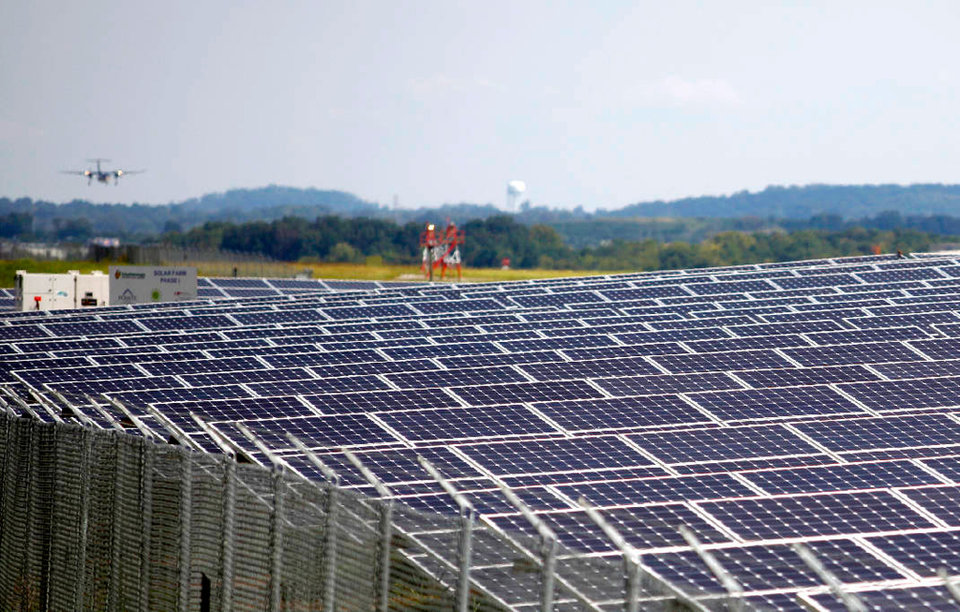ENVIRONMENT
Solar power:
the future of airport infrastructure
As energy demand continues to grow around the world, some airport operators have turned their attention skyward, and not to view the aircraft leaving and arriving. Andrew Tunnicliffe takes a look at how solar power is fast becoming the next big thing in airport infrastructure.
The aviation industry has long had its critics. From environmental groups to trade unions, governments to local residents, at some point it has been the object of scorn for one reason or another. The most striking and sustained criticism has been targeted against the vast amount of carbon emissions emanating from aircraft and facilities.
For its part, however, the sector has begun to do what it can to address the concerns and find ways of tackling the climate challenge. It has been the custodian of change in recent years. There have been developments in fuels and engine technologies – some aircraft models have even been retired, such as the bigger, fuel-consuming 747, with more energy-efficient aircraft taking their place – and infrastructure is even playing its part with airports and terminals incorporating some of the very latest sustainable models.
Image:
Image:
Melbourne Airport, Australia
If you are one of the anticipated tens of millions of passengers to travel through Melbourne Airport in the coming years, you may very well be unnerved by the sun, seemingly below you, reflecting through your window – as you’re coming into land. It isn’t your mind playing tricks, or even a trick of the light.
You’re likely seeing it reflect off one of the thousands of photovoltaic solar panels that will provide as much as 15% to 20% of the airport’s energy supply. Situated across a proposed 150,000m2, the farm will provide enough power for the site’s four terminals. It is the country’s largest project of its kind and will be operational at the country’s second busiest airport at the beginning of 2021, generating 17GW hours of electricity annually.
“With the airport’s electricity demand expected to grow, the construction of our solar farm makes sense for several reasons,” said Lorie Argus, the airport’s chief of landside access, utilities and facilities group, in a press statement. “We are committed to growing the airport in an environmentally, socially and economically sustainable way. This renewable energy project is another chapter in that story.”

Image: Melbourne Airport
Cochin International Airport, India
Situated in India’s southern state of Kerala, Cochin International Airport has enjoyed a few firsts. It was the first greenfield airport in the country to be constructed under a public-private partnership, opening in May 1999.
It’s biggest and most impressive first was that it became the first international hub to run completely on solar power, anywhere in the world. In August 2015, Cochin International switched to running on solar power alone, thanks to the more than 46,000 panels installed over a six-month period at a cost of £6.27m.
The 12MW plant provides more energy than the site needs, saving some for inclement conditions and night-time operations, while also supporting the state’s grid. Set across 45 acres of buffer land, the farm would have paid for itself within six years according to airport officials at the time. It would also save 300,000 metric tonnes of CO2 within 25 years of completion too.
The airport did not embark on this ambitious project without first testing the water. In 2013, it installed 400 panels on the roof of the arrivals terminal, providing 100kW of power, before adding to that with a 1MW expansion.
There are challenges though. As the airport continues to grow, so too must its supply of renewable energy. It is a consideration the airport’s management team is keenly aware of and continually monitoring.

Image: Santhosh Varghese / Shutterstock.com
Kuala Lumpur International Airport, Malaysia
In 2014, Kuala Lumpur International Airport installed a 19MW solar system to provide the airport with 26,000MW hours annually. The system would save $627,000 annually at current (2014) energy costs, the airport operator Malaysia Airports Holdings Berhad (MAHB) said when announcing its completion.
The location, however, posed significant challenges during the installation thanks to the lack of space. As a result, designers incorporated the panels into the facility’s roof, added ground-mounts and developed canopy-covered parking that would double up as a place to house panels. “Rooftops, parking lots and ‘buffer’ areas at airports are traditionally not multi-purpose facilities, but we've turned them into a clean energy generation facility,” said MAHB’s Managing Director Tan Sri Bashir in a press release.
Since the solar farm became operational, MAHB has also opened Kuala Lumpur International Airport 2 (Klia2). Situated around 2km from the first, Klia2 was designed to service 45 million domestic and international passengers each year. In 2019, the project was recognised for its innovation in sustainability, winning the Asia Responsible Enterprise Award.
As well as tapping into the solar energy source, the terminal uses other technologies to increase energy efficiency including lighting, smart technology in the water system and air conditioning supplied by cooled water.

Image: amirraizat / Shutterstock
Chattanooga Metropolitan Airport, US
Much smaller in comparison, the Tennessee-based domestic airport became the first in the US to receive all of its energy from solar. It claimed the title in July 2019 after years of work, which included three phases of development. It had been working towards the goal since 2011.
That year Phase I of the project was a 1MW solar farm, comprising 3,848 panels. In 2013 Phase II introduced a further 3,542 panels, adding 1.1MW. In 2019 an additional 641kW capacity solar farm with 1,886 panels completed the project.
The project was funded by a Federal Aviation Administration Voluntary Airport Low Emission Grant. Since the first farm went operational the airport has produced almost 20GW hours. It is expected to have a lifetime of between 30 and 40 years, with payback estimated to take 20 years.

Image: Chattanooga Metropolitan Airport
Minneapolis-St. Paul International Airport, US
With an average of 400,000 operations – take-offs and landings – each year, energy consumption at Minneapolis-St. Paul International Airport is significant. In what was said to be a “first-of-its-kind project”, work was completed on the installation of 11,835 solar panels in 2015.
The panels, placed on the roof of car parking structures, amounted to 3MW capacity, providing around 20% of the energy needed two-terminal site and saving in the region of $14m over 30 years. The project included the conversion of more than 12,500 lighting fixtures to LED and the introduction of four additional electric vehicle charging points, taking the total to 28.

Image: Jacob Boomsma / Shutterstock.com
Darwin International Airport, Australia
In 2016, Darwin International Airport announced it had “flicked the switch” on its 4MW photovoltaic solar array, which it said would ultimately supply all of the required energy during peak time and as much as a quarter of all daily demand.
The announcement was the conclusion of the first stage of a two-stage initiative that would raise capacity to 5.5MWs. The AU$13m project has a life expectancy of 25 years.
In 2018, the Northern Australia Infrastructure Fund announced it was supporting the further development of solar farm projects at three of the region’s airports. As part of the AU$300m package – which includes a further AU$150m in the way of loans – Darwin International Airport would develop an additional 40MW facility, Alice Springs Airport would benefit from a 10MW facility and Tennant Creek would also have a solar farm constructed, although the precise details were not known.

Darwin, Australia
Round-up
The projects covered are by no means all of those around the world. In fact, there are more than 100 airports making use of solar power generation in some way; some large, others on a smaller scale. However, they are some of the more ground-breaking projects, either because of their size, the technologies and design they incorporated or their ambition to be the first.
It is not just solar, though, that is leading the global airport community into the future. In 2012, Galápagos Ecological Airport was constructed to use both solar and wind power. In 2018, the Royal Schiphol Group announced it would start providing green energy to its airports after the completion of a three-turbine windfarm it had been developing with Eneco and the municipality of Vianen.
The future of airport power supply, and indeed demand, is changing. New technologies and methodologies look set to be at the fore of this new age of air travel.